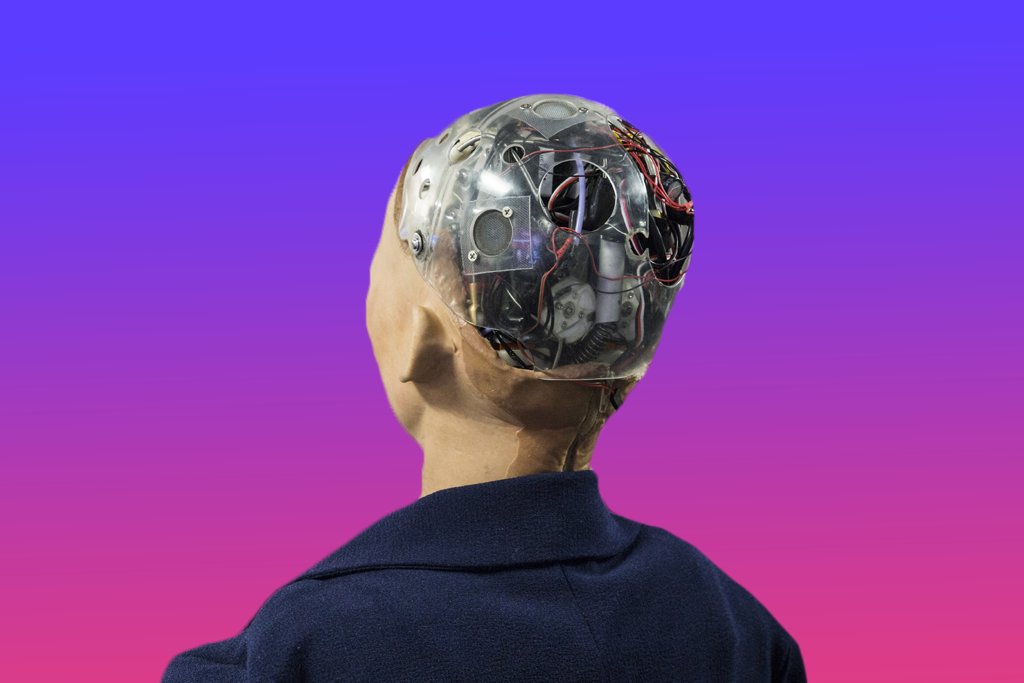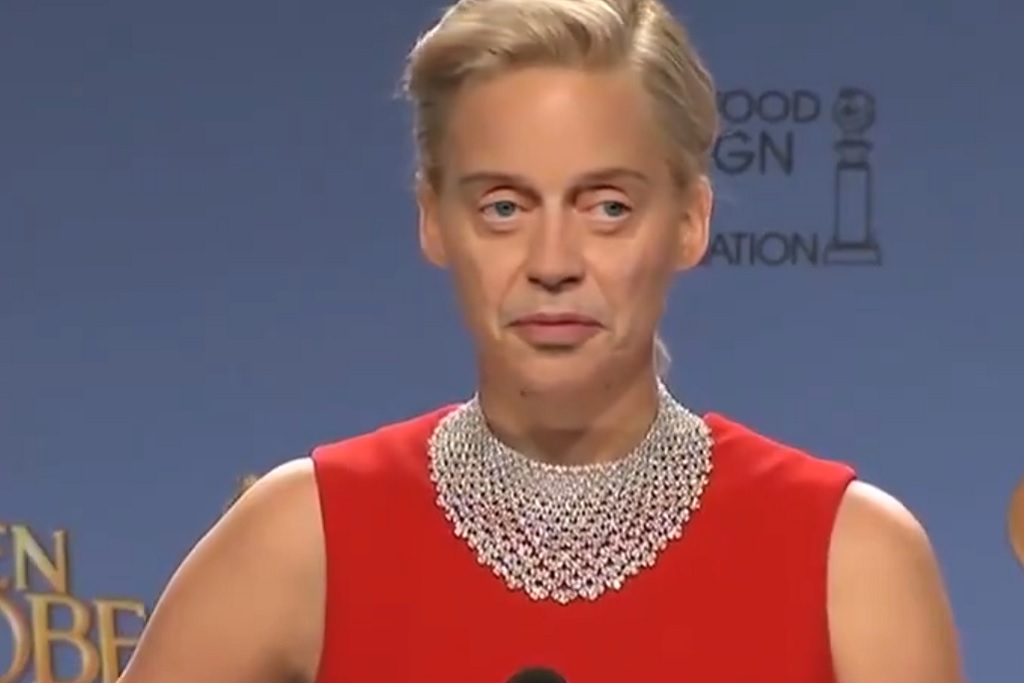Artificial Intelligence Design Is Sexist, But It Doesn’t Have To Be

This story starts with your average magazine rack circa March last year. Mindlessly browsing the covers, my eyes glazing over at the endless rows of healthy people, one magazine stood out.
There was something uncanny about this model staring out under the headlines. She was adorned in an outrageous silver gown. Her face was almost contorted in a painful show of happiness. Her lips looked dragged upwards in a smile. She looked uncomfortable, upright, maybe even confused.
Mostly, however, she looked like a robot.
This robot is called Sophia, and it’s in many ways the cover girl for the robot revolution. Designed by robotics company Hanson Robotics, Sophia’s job is to travel the world acting as brand ambassador for Artificial Intelligence.
I know this, because it is pretty well documented on Sophia’s Instagram account @realsophiarobot.
Sophia is a far cry from Artificial Intelligence. Really, Sophia is a chatbot, pre-programmed with a couple of phrases to match whatever ridiculous publicity vehicle she is trotted out on, whether it’s appearing on TV with Jimmy Fallon; dressing like some kind of Amish housemaid at Shanghai Fashion Week; to then whirling around to encourage young women to study STEMM.
But as the face of AI, Sophia is a perfect example of a serious problem emerging in the field of AI. A gender problem.
Stop right there you leftie feminist, AI doesn’t have a gender!
Technically this is true. The millions of lines of code executing programmed functions are by every definition genderless.
However, we ordinary plebs can’t interact with code. We can’t tell code to show us the weather, and we certainly can’t flirt with it, take it to the beach, and write it poetry (hey there, Spike Jonze!). In order to engage with Artificial Intelligence, it needs to meet us halfway. We need to interface with them and for that AI needs a voice. Sometimes it needs a face or a body too.
Overwhelmingly, these human-ed up version of AI are female.
Amy Chambers wrote about how our collective imagination has a strange tendency to imagine AI as female. From Samantha in Her, to Ava and Kyoko in Ex Machina, and Joi in Bladerunner 2049, AI are all women who are designed to be subservient to the main character’s needs (although they may not stay that way). Even in the most basic low-budget depictions of artificial intelligence (*Ahem* Disney’s 1999 Smart House), AI still takes on this same subservient femininity.
You don’t have to look far to see this spilling over into real life. Alexa, Siri and Cortana are all generally assumed to be female. Before you cry foul that they have male voices too, yes you’re right, but the default is usually a pleasing female. If you snap-polled whatever room you’re in right now they’ll likely tell you Alexa is a woman.
There is a whole wide world of Artifical Intelligence that isn’t gendered like all the stuff in use in finance. But the moment you cross over into domestic AI – that is, Artificial Intelligence designed to help us with our everyday lives – gender comes barrelling into play.
This issue stems from our fear of AI.
What’s more, this isn’t some innocent quirk of technology. It’s not random. It’s insidious peddling of outdated gender stereotypes dressed up in shiny new chrome. And it’s worrying because for a field at the forefront of shaping what our future will look like, Artificial Intelligence actually looks a lot like nostalgia for a conservative past.
At a base, fundamental level this issue stems from our fear of AI. Because when you get down to it how far are we away *really* from a Terminator-level full global meltdown? Let’s face it, humanity, on the whole, is not doing a great job and it’s not hard for us to ponder beings better than us. There’s plenty of fiction about AI at war with humanity, and, let’s not forget, these depictions tend to be authoritative, threatening, and (drum roll please) male.
“Robots taking over” isn’t a great selling point for the far less advanced and much more commercial Artificial Intelligence we have now. If we’re going to do what a quarter of Americans have done and welcome Amazon Alexa into our homes, this AI needs to be the exact opposite of the Terminator. We can’t be lying awake at night fearing Alexa will go all Chucky on us the moment we lower our guard. Alexa needs to be friendly and, above all, submissive.
When programmers and engineers from an overwhelmingly male-dominated industry look for a way to design these user-friendly robots they don’t go much further than textbooks of Lazy Stereotyping 101. When you need to create a face that is pleasing and acceptable you turn to “traditional” femininity.
This isn’t a version of womanhood that actually exists. Female AI doesn’t come anywhere close to the real-life spectrum of experiences of womanhood. You know, women of diverse backgrounds, sexualities, presentations, differing abilities. And it’s not trying to. Its aim is only to please, and this is why we end up with AI that looks, sounds, and acts like a housewife.
This might sound innocent and superficial. But, obviously, I wouldn’t be writing this if it stopped there.
In fact, there’s plenty of evidence that shows that gendered AI actually perpetuates troubling and sometimes violent attitudes towards women. One study found that while we’re aware Alexa isn’t an actual woman, the simple act of giving her a woman’s voice is enough to trigger the kind of assumptions mentioned above. These kinds of assumptions make it far less likely to treat Alexa as a source of authority and respect. And with no respect comes abuse.
Take this video of a guy bombarding Alexa with the same moronic line of questioning you might expect while being harassed on a night out:
Alexa’s programmed responses feed the trolls, answering coyly to some questions “Alexa, are you a lesbian?”, while giving blank stares to others “Alexa, will you marry me?”. In typical male form when Alexa declines his marriage proposal, he calls it a bitch. (On second thought don’t watch the video? This guy sucks.)
This isn’t just limited to douchebags on Youtube. There’s a whole generation of kids growing up with smart devices. Some parents are noticing that when kids don’t get their way with Alexa they lose their temper and get mad at it. It’s a well-documented fact that kids are little shits 90 percent of the time. The difference is that when kids are rude to adults they get a lesson in manners.
But Alexa? Alexa lets it slide.
This would be fine if kids could distinguish between talking to a human and talking to a robot. But when they’re three years old many just think Alexa is a “small woman inside a machine”.
Some companies have added features to their AI encouraging kids to be polite, but there’s been a weirdly gendered backlash to this. Not everyone thinks we should be treating AI the same way we treat humans. These critics say AI is programmed to help us, not to be equal. They’re less than.
Of course, this is a lot easier to imagine when AI is female.
So how do we actually fix this?
There’s no easy answer. The ongoing problems with gender and race in tech industries is a complex beast. That’s why simply saying “we need more women in STEMM” is a bit of a cop-out. Plenty of women want to work in STEMM, but as the worldwide Google walk-off showed, it’s not as if the red carpet suddenly rolls out for you when you decide to study engineering. It’s the fields themselves, built upon exclusionary values, that need to change. And plenty of people are out there trying to change it.
Part of this is happening by imagining what alternatives could look like. Thanks to the team at Feminist Internet we have some idea of how we might interact with genderless AI. That is, AI that not only challenges gendered representations but also doesn’t put up with abuse.
But like with all issues change doesn’t happen on its own. It also takes people speaking out, because if we don’t use our voices we’re silently consenting to this vision of the future that imagines more than half the population as passive helpers. And with technology expanding and advancing at a rate unknown in human history, it’s not long before imagination turns into reality.

